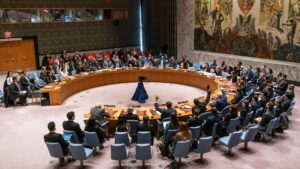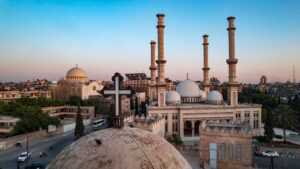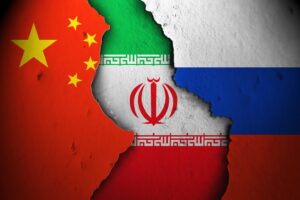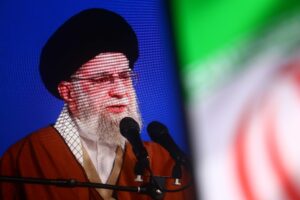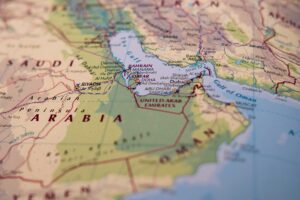This article is part of a multi-part series on Arab Gulf security.
More than any other Arab Gulf state, Bahrain reflects the contradictions and conflicts of its past—an ossified British colonial political structure without the British. Al Khalifah rule is a byproduct of Pax Britannia—the Al Khalifah happened to be at the right place at the right time. Contemporary Bahraini stability and security challenges are rooted in the dynamics of Al Khalifah state formation and Great Britain’s role in solidifying their tribal, minority rule. As a result, political ‘reform’ in Bahrain can only be superficial in dealing with temporary crises. Fundamental change would upend the political status quo and end Al Khalifah rule—potentially jeopardizing the Arab Gulf security paradigm.
From its inception, Al Khalifah rule over Bahrain was fraught with conflict. The indigenous peoples of the islands—Baharnah Shi’a and Huwala Sunni Arabs—viewed the Nejdi tribal clan as outsiders who imposed their rule by force on a pre-existing set of societies. The Al Khalifah policies which maintained and reinforced political, economic, and social separation were in effect self-isolating solidifying the idea among indigenous groups that the rulers were, in fact, outsiders. This system put the Al Khalifah family, with its various competing clans, at the pinnacle of a pyramid composed of Bahrain Sunni groups, Sunni Arab indigenous and emigres, non-Arab Sunni Muslim minorities, and other minorities consisting of Jews and East Asians, with the indigenous Shi’a Arab majority at the bottom. At times inadvertently and at other times intentionally, British interventions and outright rule served to harden the societal divides of this stratified society whilst key colonial British personnel brought their own attitudes and approaches from colonial Africa and ensuring Al Khalifah dominance.[i]
The Al Khalifah have survived myriad threats including episodes of near self-destruction in large part because Britain and later the United States viewed potential alternatives to Al Khalifah rule as unacceptable to Arab Gulf security and stability and, thus, Western interests. The contemporary events in Bahrain echo, if not mimic, the past. The propensity to forget the fundamental conflicts—whether clan struggles within the Al Khalifah, sectarian struggles, rivalries with other Arab states, abject fear of the Persians, or frustrations with Western allies—have all happened before with predictable strategic results. The following analysis of Bahrain examines the present through the prism of the past.
Bahrain to 1945
The Safavid alliance introduced Jafari Twelver Shi’sm and Bahrain, along with Lebanon and southern Iraq, became centres of Shi’a scholarship.
With regards to Bahrain, there is arguably “nothing new under the sun,” or at least not much. From the 3rd century CE until the advent of Islam, Bahrain was a trading centre, refuge, and a cultural and sectarian melting pot dominated by the Persian Sassanian Empire.[ii] In the early Islamic period, Bahrain became a haven for opponents of the Umayyad (661–750) and the Abbasid Caliphates (750–1258), harbouring Kharijite, Sunni, and Shi’a opposition groups including the notorious Ismaili Qarmatians.[iii] The perpetually feuding Sunni Hawala Arab dynasties dominated much of the Medieval period only to be subjugated by the Portuguese and their Hormuzi Arab allies in the 16th century.[iv] In the 17th century, the Bahrainis allied with the Safavid empire of Shah Abbas the Great (r. 1588–1629), and the British East India Company (BEIC) expelled the Portuguese. The Safavid alliance introduced Jafari Twelver Shi’sm and Bahrain, along with Lebanon and southern Iraq, became centres of Shi’a scholarship.[v] For the next 150 years, Twelver Shi’sm dominated not only Bahrain but also significant portions of eastern Arabia and Iraq. From the beginning, Bahrain was a crossroads of cultures and conflicts.
In the 18th century, ferment in the Gulf—the collapse of Safavid Persia, the weakening of Ottoman control, the rise of the Wahhabi Saudi Emirate, and the emergence of an increasingly assertive British policy—defined contemporary Bahrain. Part of the Utub migrations, the Al Khalifah sought to escape their subordinate position to the Al Sabah in Kuwait. Between 1762 and 1766, the Al Khalifah established themselves in the Zubarah region of Qatar.[vi] In 1783, Sheikh Ahmad al-Fatih bin Khalifah Al Khalifah, also known as “The Conqueror,” (r. 1783–1796) defeated the Abu Shahr and took control of Bahrain.[vii] Subsequent Persian and Huwala Arab attempts to recapture Bahrain failed.[viii] However, Sheikh Ahmed’s death in 1796 brought internal dynastic instability.[ix] Persian threats, Saudi incursions, and Omani invasions in 1803 led the Al Khalifah to seek the “protection” of the First Saudi State which included the removal of the Al Khalifah family to Dir’iyah for “safe-keeping.”[x] Among the Al Saud, Bahrain is periodically viewed as a natural extension of Nejd.[xi]
With some minor adjustments, the Qatari Embargo 2017–2020 mirrored the Qatari-Bahraini War of 1867–68 in terms of participants, causes, and outcomes.
In the aftermath of the Saudi defeat by the Ottomans in 1818 and the British defeat of the Qassimi in 1819, the British demanded that the Arab Gulf emirates sign Maritime Trucial Treaties in 1820 and 1835. These agreements provided the Al Khalifah with a potential shield against their external enemies, leaving them to focus on internal and dynastic threats.[xii] In the 1830s and 1840s, internal Al Khalifah rivalries resulted in co-rulers. In 1861, the British demanded that Sheikh Mohammed bin Khalifah sign a more comprehensive Trucial agreement or face a British blockade and potential removal. He signed and received British recognition as ruler.[xiii] The 1860s brought more Al Khalifah instability. In 1867, Mohammed bin Khalifah attempted to overthrow the Al Thani on the Qatari peninsula. The Al Thani defeated the Bahrainis and the Al Nahyan of Abu Dhabi. The British resident arrived and acted.[xiv] The British recognized the Al Thani as the legitimate rulers of Qatar and endorsed the expulsion of the Al Khalifah from the Qatari peninsula. They then removed and imprisoned Mohammed bin Khalifah and replaced him with Sheikh Ali bin Khalifah Al Khalifah (r. 1868–1869). Sheikh Ali’s murder resulted in the British making his son Sheikh Isa bin Ali Al Khalifah (r. 1869–1923) the new ruler. In short, the Bahraini-Qatari War was a disaster for the Al Khalifah rulers. With some minor adjustments, the Qatari Embargo 2017–2020 mirrored the Qatari-Bahraini War of 1867–68 in terms of participants, causes, and outcomes underscoring the durability of Al Khalifah rivalries.[xv]
Sheikh Isa seized cultivated land, fisheries, pearling rights, and anything of value that might benefit the Al Khalifah.[xvi] In 1880, concerned over Ottoman attempts to reestablish themselves, the British forced Sheikh Isa to hand over control of foreign policy, defense, and commercial policy.[xvii] Although the “Exclusive Agreement” of 1891 expanded British control, Sheikh Isa managed to provoke a general revolt in 1895—only British intervention saved him. The British contemplated the Sheikh’s removal but time and again, concluded that it was better to deal with who they knew. In the aftermath of World War I, British patience ran out; they replaced Isa with his son, Sheikh Hamad bin Isa Al Khalifah (r. 1923–1942), and demanded that the new emir initiate fundamental reforms.[xviii]
The Reforms of the 1920s, Arab Nationalism, and Independence
The British realized that their traditional Gulf Residency model was insufficient to assist the Al Khalifah in adjusting to the realities of the 20th century—a new approach was required. In 1926, the British Colonial Office forced the ruler to employ Charles Dalrymple Belgrave, a former colonial officer in Egypt and Tanganyika. He served for the next three decades as secretary to Bahraini rulers overseeing government reform.[xix] Belgrave’s “New Regime” met with immediate resistance from the now-deposed Sheikh Isa and his allies of convenience, the al-Khawalid. The hardliners formed the Bahrain National Council (BNC) demanding the restoration of Sheikh Isa and an end to British interference. The al-Khawalid and other conservatives feared Belgrave’s advocacy of a middle path of political compromise between the Al Khalifah and the Shi’a community.[xx] Al-Khawalid were banned from the Bahraini government by the British until independence in 1971. The Belgrave reforms created a modern Bahraini state, but the sectarian “middle path” failed.[xxi] Belgrave’s efforts and the Shi’a reform movement of 1935 “sparked the Shi’a community’s awareness” as the majority and brought demands for greater power and representation. This growing political awareness laid the groundwork for multiple Shi’a political movements that would attempt to take power in the future.[xxii]
Nasserism targeted the British and the Al Khalifah strengthening their cooperation.
In 1954, influenced by Arab Nationalism and Nasserist Egypt, young Bahrainis formed the National Union Committee (NUC) calling for a “mobilization of nationalist forces” to challenge the status quo. Ideologically, Nasserism targeted the British and the Al Khalifah strengthening their cooperation. The NUC had three primary demands: an end to sectarianism, removal of the British presence, and an end to the “tribally controlled regime.” NUC influence brought the rise of the General Trade Union (GTU) and merged with other nationalist groups to agitate for revolutionary reform.[xxiii] In 1957, the British arrested the NUC leadership but unrest continued. In 1965, cells of Arab National Movement (ANM) and the National Liberation Front (NFL) incited the so-called “Intifada Mars” that culminated in a major general strike.[xxiv] With the blessing of the British, the Al Khalifah enacted the repressive 1965 security laws that gave Bahraini security forces a largely unrestrained hand to contain the opposition. The British also provided a colonial police officer, Ian Henderson, as security advisor to the Al Khalifah. He headed the security service until 2012.[xxv]
In 1968, a beleaguered Britain announced it would withdraw from the Gulf by 1971. Bahrain was a three-fold challenge. Firstly, the Shah revived Iranian claims to Bahrain. Secondly, the Al Khalifah defence forces were inadequate. Finally, Bahrain’s position vis-à-vis the other emirates of the Gulf had to be defined. The British induced the Shah to drop Iran’s claim.[xxvi] Simultaneously, the British worked to upgrade the security services and create a military.[xxvii] Lastly, the original British concept of a nine-member federation of emirates failed with Bahrain and Qatar becoming independent.
Independence to the 21st Century
Taking the title of emir, Isa created a Constitutional Assembly which led to a revolt by the Peoples’ Bloc, a leftist organization, and the Shi’a Religious Bloc. Attempting to defuse the situation, the Emir authorized a Constituent Assembly that met from 1973–1975 and promptly demanded an end to the State Security Decree of 1974 and revocation of U.S. Navy basing rights in Bahrain. In 1979, the Iranian Revolution removed US concerns regarding the Al Khalifah’s rule over the Shi’a; Ayatollah Ruhollah Khomeini’s anti-American hostility made democracy and any potential for Shi’a rule in Bahrain unthinkable. Encouraged by senior Bahraini Shi’a clerics, major pro-Iranian demonstrations called for the application of Islamic principles in governance, and the Bahrain Islamic Freedom Movement agitated for ‘democratic’ reforms.[xxviii] A group calling itself the Islamic Front for the Liberation of Bahrain (IFLB), supported by the Iranian security services, was caught attempting to overthrow the government. This played directly into the hands of the Al Khalifah hardliners led by the prime minister and brought a mutual defence pact with Saudi Arabia.[xxix] In effect, Iran became the best ally of the hardliners in Manama.
The US inherited a British relationship with a state ruled by a tribal-sectarian elite Quite naturally, Saudi Arabia had no qualms at all about supporting the Al Khalifah. They allocated crude oil to the Bahraini refinery, handed Manama production from a Saudi oil field, and assisted in creating a Bahraini banking industry. The Kingdom also funded dual-use projects like the causeway linking Bahrain with the mainland and bolstered trade and security cooperation. Nevertheless, sectarian unrest and political dissent continued as did an increasingly securitized state.
The opposition wanted nothing short of reforms that would ultimately end Al Khalifah rule.
In 1992, this situation became a political issue for the Bush administration. After the 1990–1991 Iraq War emphasized the evils of authoritarian and minority rule, critics pointed to the US alliance with Bahrain. This brought new pressure on the Al Khalifah to reform, thus driving the ruler Sheikh Isa bin Salman to create a Consultative Assembly. Appointed for a four-year term, the membership was carefully screened. In 1994, economic stresses brought Shi’a demands for reform, and this confrontation resulted in the exile of Shi’a Sheikh Ali Salman and the arrest of Bahrain’s leading Shi’a cleric, Imam Abd-al-Amir al-Jamri. Unrest continued. In 1996, the government offered an expanded Consultative Assembly,[xxx] which included five Shi’a members,[xxxi] but failed to appease the opposition. [xxxii] Emir Isa then reshuffled his cabinet by appointing five Shi’a ministers. Derided as a hollow political gesture by the opposition, the unrest continued. The opposition wanted nothing short of reforms that would ultimately end Al Khalifah rule.
The 21st Century: New Rulers and Old Problems
Sheikh Hamad issued a new National Charter that changed Bahrain to a monarchy, created a bicameral National Assembly, freed Shi’a prisoners, and allowed exiles to return.
In 1999, Emir Isa unexpectedly died and his son, Sheikh Hamad bin Isa Al Khalifah, became emir. Many believed that Prime Minister Sheikh Khalifah would rule behind the façade of the new emir. Since independence, the return of al-Khawalid hardliners, in the form of Khalifah bin Ahmad Al Khalifah, Commander Bahraini Defence Forces, and Khalid bin Ahmed Al Khalifah, Head of the Royal Court, complicated the family dynamic.[xxxiii] There was speculation that the combination of the prime minister and the al-Khawalid might eclipse Hamad’s line.[xxxiv] Perhaps sensing the same threat, in 2002, Sheikh Hamad issued a new National Charter that changed Bahrain to a monarchy, created a bicameral National Assembly, freed Shi’a prisoners, and allowed exiles to return. The new upper house of the Majlis, appointed by the King, now approved laws passed by the elected lower house. In 2006, Shi’a parties took 40 per cent of the vote with the Al Wefaq Islamic Society demanding a Majlis with “real legislative power.” The Al Khalifah refused, falling back on a balancing act of prisoner releases and security crackdowns. It was not enough.
In 2011, the ‘Arab Spring’ ignited the Bahraini opposition once again. Crown Prince Salman bin Hamad Al Khalifah’s attempts to reach an accommodation with the opposition collapsed when Prime Minister Khalifa bin Salman and the al-Khawalid hardliners called for intervention by the Gulf Cooperation Council (GCC).[xxxv] While neither the King nor the Crown Prince would have met the opposition’s demands, the appearance of unliteral action on the part of the hardliners threatened to undermine the monarchy. The relative restraint of Bahraini security forces when compared to Yemen or Syria shielded the regime from a punitive U.S. reaction, but the post-unrest legal proceedings damaged the regime. The size and resilience of the demonstrations surprised and frightened the regime, and the panicky call for GCC intercession damaged its legitimacy.[xxxvi]
Some Gulf analysts argued that the crackdown ruptured the traditional relationships between Al Khalifah, wealthy Shi’as, and the young professional class. Many Western businesses left or reduced their presence turning Manama into a “ghost town.” In 2012, the prime minister argued that reform was not the issue, but rather that the opposition and the al-Wefaq spiritual leader, Ayatollah Isa Ahmed Qasim, were in fact Iranian agents attempting to turn Bahrain into a “second Iran.”[xxxvii] Sheikh Khalifa and the al-Khawalid appeared to undermine any chance of compromise.[xxxviii] In reality, short of an end to Al Khalifah rule—the opposition’s demand for centuries—no compromise was possible.[xxxix] Neither the regime nor the Saudis, the GCC, or the West could support that.
Since 2011, political parties and associations including al-Wifeq, al-Waad, Al Haq, and Sunni Islamist groups are banned with their leadership in exile or prison. The “National Dialogues” promoted by Crown Prince Salman bin Hamad offered no significant reform.[xl] This was, of course, correct because the opposition’s desire for reform was political suicide for Al Khalifah rule. In addition, the other traditional rulers of the Arab Gulf understood the negative implications of an Al Khalifah collapse. For the Arab Gulf, the implications of a Shi’a-dominated Bahrain, either neutral to or aligned with Khomeinist Iran, were simply unthinkable. The implications for the West and the United States were almost as problematic.[xli]
From a dynastic point of view, countering the internal challenges of Prime Minister Sheikh Khalifa and the al-Khawalid to Crown Prince Salman were a priority.
In the aftermath of 2011, King Hamad’s primary quandary was the age-old challenge for all Al Khalifah rulers. Maintaining control of Bahrain was more than just containing the opposition. From a dynastic point of view, undermining the internal challenges of Prime Minister Sheikh Khalifa and the al-Khawalid to Crown Prince Salman were a priority. Hamad also needed to broaden support for his clan within the Al Khalifah tribal structure and reach outside the family as well. Support from Crown Prince Mohammed bin Zayed, at the time the de facto ruler of Abu Dhabi, the Saudis, and of course, the United States have proven vital to King Hamad and Crown Prince Salman’s reassertions of royal prerogatives.
National Charter or not, challenges to succession and the prerogatives of a new ruler had been historically the rule within the Al Khalifah rather than the exception. (The relatively smooth successions between 1869 and 1971 came from British control.) The National Charter of 2002 was merely the opening salvo of a power struggle within the Al Khalifah and had done little to stymie the actions of the prime minister and the al-Khawalid during the 2011 rebellion. Those events left the impression that the King and Crown Prince had been side-lined. King Hamad’s relationship with the hardliners notwithstanding, they viewed Crown Prince Salman bin Hamad with suspicion. Bahrain’s hereditary monarchy requires proactive policies by King Hamad to ensure that it becomes a reality.
This effort required patience. In 2013, the King appointed the Crown Prince as First Deputy Prime Minister. Sheikh Khalifah bin Salman attempted to resist this threat to his power and to his descendants’ futures but failed.[xlii] When he died in November 2020, the Crown Prince became prime minister.[xliii] Hamad had also systematically moved other sons into key positions as national security advisor and commander of the Royal Guard. Modeled on the UAE Presidential Guard, the Royal Guard became the premier military formation designed to protect the ruler and his family. These moves were at the expense of other Al Khalifah factions, particularly the BDF commander, Sheikh Khalifah bin Ahmed Al Khalifah. During the Trump administration, Bahrain joined the Abraham Accords with Israel to strengthen its influence in Washington. In June 2022, a cabinet reshuffle, apparently organized in secret by the Crown Prince and Prime Minister Salman bin Hamad, changed seventeen of twenty-two positions. The hardliner ministers of oil and justice were removed; the latter was an al-Khawalid and the son of the BDF commander. Sheikh Khalifah bin Ahmed retained his position as did his brother, the minister of the royal court, Sheikh Khalid bin Ahmed. The prime minister also replaced the Deputy Prime Minister, Ali bin Khalifa Al Khalifa, the son of the former prime minister and another hardliner. The King endorsed this latest change as did both the Emiratis and the Saudis. Five Shi’a ministers were appointed to the new cabinet.
Stability of succession is important, and potential challenges or alternate centres of authority constitute a security and stability problem.
Given that the Al Khalifah are not going to adopt reforms that will loosen their grip on political power, why do cabinet reshuffles matter? First, stability of succession is important, and potential challenges or alternate centres of authority constitute a security and stability problem. To the degree possible, the Bahraini population, the GCC partners, and Western allies need to know who is in charge and who will ascend the throne. In addition, should the King and Crown Prince be able to coopt a broader spectrum of Bahraini society including some Shi’a, then dynastic stability is improved, even if the improvement is temporary. Over the long term, instability and conflict will be an ongoing endemic part of the political equation and the balancing act will continue no matter who is in power. The Al Khalifah regime cannot share political power with its opponents and survive. Because Bahrain lacks the wealth to damp down the economic disparities that drive the political and social unrest, the ability to coopt is limited leaving only the balancing act.
There is no ‘solution’ to this problem. In fact, there would still be no solution were the Shi’a or another group to rule. In the end, each would revert to some form of authoritarian system to maintain control. There is ample reason to believe that were any of the current opposition groups in political power, well-meaning Bahraini democracy advocates would ultimately fall victim to authoritarian Islamist elements.[xliv] The best that can be hoped for is a rule that provides broad-based economic opportunity, societal stability, and security. There is hope that perhaps a new generation of the Al Khalifah with a more inclusive societal vision can reduce the level of friction.[xlv] To understand Bahrain and Al Khalifah rule is to understand that this conundrum has been fundamental to the political, economic, and socio-cultural construct of the country since the 18th century. The political narrative among the Shi’a is a real, if idealized, past of subordination by whom they view as Sunni invaders – there is little or no room for lasting compromise.[xlvi]
The Al Khalifah have clung to power despite continual opposition from one group or another. They managed to control this kaleidoscope of political and sectarian challenges, and for more than two centuries, their rule over Bahrain has been viewed favorably. As this short narrative illustrates, there is an ebb and flow but most of the sources of instability and unrest that date from the 18th century remain in Bahrain. As a result, a degree of instability, internal tribal issues, the political and diplomatic balancing act, and the necessity of Arab Gulf and Western support for the regime’s survival will continue. Notwithstanding, the Al Khalifah will continue to be trusted partners for both Arab Gulf security and Western interests into the foreseeable future.[xlvii]
[i] To blame the British colonial experience as the root cause of the current Al Khalifah top-down political structure in Bahrain is simplistic. Imperial interests coalesced with Al Khalifah dynastic interests to produce the current system; nevertheless, other forms of colonial or imperial rule in the Middle East and Central Asia – Ottoman, Safavid, French, Russian, etc.—were no less hierarchical and their heritage no less politically stifling than that of the British. In fact, one might also argue that Lord Lugard’s 1922 British “dual mandate” imbued many local political leaders within the British Imperial system with a greater sensitivity to Western concerns with regard to the 20th and 21st century ‘rules of the road’ for top-down rule. Lugard and others have them more sensitive to the pitfalls of naked repression and thus more competent at managing their Western allies. Their Western interlocutors and advisors no doubt have played a role in this balancing act. In giving credit where credit is due, the rulers of the Arab Gulf have displayed an aptitude for maintaining authoritarian rule while shielding themselves from the worst consequences of their actions that dynastic survival compelled them to take. In other words, they learned early on to play the balancing act between despotic rule and the sensibilities of Lugard’s “dual mandate” in order to survive. See Lord Lugard, The Dual Mandate in British Tropical Africa (London: Archon Press – Fifth Edition, 1965): 193–214.
[ii] For example, there is some indication that a relatively large Nestorian Christian community developed in Bahrain seeking refuge from Orthodox Christian persecution. Clive Holes, Dialect, Culture, and Society of Eastern Arabia (Leiden: Brill, 2001); xxiv–xxvi. See also R.B. Serjeant, “Fisher-Folks and Fish-Trap in al-Bahrain,” Bulletin of the School of African and Oriental Studies, University of London (Vol. 31, No. 3, 1968)
[iii] The Qarmatians raided pilgrim caravans, sacked Mecca during the Hajj, and stole the stone from the Kaaba. Ira H. Lapidus, A History of Islamic Society (London: Cambridge University Press, 1988): 60. Angela Clark, Bahrain: A Heritage Explored (London: MEED Books, 1986): 14.
[iv] Joao Teles e Cunha, “The Portuguese Presence in the Persian Gulf,” in the Persian Gulf in History, edited by Lawrence G. Potter (New York: Palgrave Macmillan, 2008): 209–212. See also Willem Floor, A Political and Economic History of Five Port Cities, 1500–1730 (Washington, D.C.: Mag Publishers, 2008): 124–125. The Qarmatians were ostensibly Ismaili Shi’a, and in the 10th century conquered most of the Arabian Peninsula, threatened Baghdad, and in 930 raided Mecca during the Hajj, slaughtering pilgrims removing the “Black Stone of the Kaaba.” Following the Qarmatian interlude, Bahrain was ruled by a series of local sheikhs most often vassals of one Persian governor or another from across the Gulf. In short, Bahrain had a well-established Shi’a sectarian identity dating from the early Islamic period, but the post-Qarmatian period tended toward Sunni Huwala Arab dominance with Persian backing.
[v] Devin Stewart, “The Genesis of the Akhbari Revival,” in Safavid Iran and Her Neighbors, edited by Michel Mazzaoui (Salt Lake City, UT: University of Utah Press, 2003), 188.
[vi] During the first half of the 18th century, multiple attempts by Ibadi Oman to fill the void left by the Safavid collapse brought mixed results. In 1742, Persian forces allied with local Sunnis Huwala Arabs ejected the Omanis. An indigenous Huwala dynasty eventually emerged under the leadership of Sheikh Nasr al-Madhdur of the Abu Shahr. He convinced the BEIC to move its trading centre from Bandar Abbas to Bushier which he also controlled. Ahmad Abu Hakima, History of Eastern Arabia: The Rise and Development of Bahrain and Kuwait (Beirut: Khayats, 1965): 84–89.
[vii] Jill Crystal, Oil Politics in the Gulf: Rulers and Merchants in Kuwait and Qatar (London: Cambridge University Press, 1995): 26.
[viii] Willem Floor, The Persian Gulf: The Rise of the Gulf Arabs 1749–1792 (Washington, D.C.: Mag Publishers, 2007): 233.
[ix] Sani Ali Bashir, A Study of the al-Khalifah’s Rule in Bahrain, Dissertation (Montreal: McGill University, 1979): 46.
[x] The Saudi capture of Mecca and Medina in 1811 brought an overwhelming Ottoman response in the form of Mohammed Ali’s Egyptian army. In 1818, the Egyptians destroyed the First Saudi Emirate (1744–1818) and, in the Gulf, the British destroyed the Al Qassimi, the Saudi’s principal ally Fuad Ishaq Khuri, Tribe and State in Bahrain: The transformation of social and political authority in an Arab state (Chicago: University of Chicago Press, 1980): 26.
[xi] Discussion with senior Saudi Military officers in Fall 2012 and the potential for federated Arab state encompassing Saudi Arabia, Kuwait, and Bahrain with Riyadh as the capital. Both cited the Nejdi origins of the Al Sabah and the Al Khalifah, the Saudi historical claims to both areas, and what they saw as the relative weakness of both regimes in support of their arguments for a federation.
[xii] J. B. Kelley, Arabia, the Gulf, & the West (London: George Weidenfeld and Nicolson Limited, 1980): 188–202, 220, 380–384. See also, James Onley, The Arabian Frontier of the British Raj: Merchants, Rulers, and the British in the Nineteenth-Century Gulf (London: Oxford University Press, 2007): 56–57.
[xiii] Arnold T. Wilson, The Persian Gulf: An Historical Sketch from the Earliest Times to the Beginning of the Twentieth Century (London: George Allen & Unwin Limited, 1954): 247.
[xiv] J.B. Kelly, Britain and the Persian Gulf, 1795–1880 (Oxford: The Oxford Press, 1968): 684–685. See also, Talal Toufic Farah, Protection and Politics in Bahrain 1869–1915 (Beirut: American University of Beirut, 1985): 35. In 1869, Colonel Lewis Pelly, the Permanent Resident, reorganized the entire ruling structure in Bahrain despite complaints from the Al Khalifah, the Ottomans, and the Persians.
[xv] Angela Clarke, Bahrain: Heritage Explored (London: MEED Books, 1986): 21.
[xvi] Abdulhadi Khalaf, “Contentious politics in Bahrain: From ethnic to national and vice versa,” Fourth Nordic Conference on Middle Eastern Studies: The Middle East in Globalizing World, Oslo (August 13–16, 1998): http://www.org.uib.no/smi/pao/khalaf.html. The British took the entire Al Khalifah family hostage and demanded compliance with the Trucial agreements. Mohammed bin Khalifah, the ruler, was imprisoned on Ceylon (Sri Lanka) before being handed over to the Ottomans and dying a prisoner in Mecca. His ally Mohammed bin Abdullah was captured and imprisoned in Aden until his death. The entire incident provided a clear example of the downside of excessively disappointing the British.
[xvii] Briton Cooper Busch, Britain and the Persian Gulf, 1894–1914 (Berkeley: University of California Press, 1967): 134.
[xviii] Busch, Britain, 379–380.
[xix] Khalaf, “Contentious Politics in Bahrain.”
[xx] Charles Belgrave, Personal Column (Beirut: Librarie du Liban, 1960): 25. It must be remembered that from the arrival of the Al Khalifah in the late 18th century until 1947 and Indian independence, Bahrain and the Persian Gulf was ruled (or managed) by British Indian administration in Bombay. Their approaches to colonial rule differed somewhat from that of the Foreign Office or the African Colonial Office. That said after World War I, the methodology of colonial rule followed a general set of parameters that relied on indirect control through local rulers. Local rulers who lost control became a problem and were given hands-on British assistance in ruling and reforming their state. The problem of the Al Khalifah was to the greatest degree like the problems of rule and reform in Africa. First there was the issue of ‘white control.’ Second, came the challenge of modernization – creating a modern administration from basically nothing, and finally, came the issue of assisting the indigenous leadership in controlling/coopting the population. Perhaps more than any other state in the Persian Gulf, Bahrain’s challenges were most similar to those reflected in the African colonial experience and thus people like Belgrave and later Ian Henderson were a perfect fit for creating a system that maintained settler rule.
[xxi] There was a significant level of overly optimistic reporting on Belgrave’s success. The British resident in Bahrain, C.C.J. Barrett, reporting on the “improvement” in sectarian relations stated: “Because of the reforms Shiites feel that they have gained security and justice for the first time in 150 years and have begun thinking about their rights.” The reality was significantly different. Shaul Yanai, The Political Transformation of the Gulf Tribal States: Elitism and the Social Contract in Kuwait, Bahrain, and Dubai, 1918–1970s (Chicago: Sussex Academic Press, 2015): 36.
[xxii] Shaul Yanai, The Political Transformation of Gulf Tribal States: Elitism and Social Contact in Kuwait, Bahrain and Dubai 1918–1970s, (Brighton, UK: Sussex Academic Press, 2016): 136.
[xxiii] Malcolm C. Peck, Historical Dictionary of the Gulf Arab States (Toronto: Scarecrow Press, Inc., 2008): 39.
[xxiv] Khalaf, “Contentious politics in Bahrain.”
[xxv] Henderson was famous for his role in suppressing the Mau Mau Revolt in Kenya in the 1950s. Henderson was expelled by the government of Kenya after independence in 1964 and moved into his role as security advisor to a regime in Bahrain. The opposition referred to Henderson as the “Butcher of Bahrain.” John Silverman, “Is the UK facing up to Bahrain’s past?” BBC News (April 16, 2003): http://news.bbc.co.uk /2/hi/uknews/2842535.stm.
[xxvi] Jane Kinninmont, “Bahrain,” in Power and Politics in the Persian Gulf Monarchies, edited by Christopher Davidson (New York: Columbia University Press, 2011): 37. The author suggests that the Shah gave up his claim to Bahrain in return for a British promise of non-interference in his occupation of three islands—Abu Musa and the Greater and Lesser Tunbs—claimed by the United Arab Emirates.
[xxvii] Ian Henderson, often referred to as the “Butcher of Bahrain,” and Sheikh Khalifah, represented an interesting confluence of settler attitudes and practices for enforcing minority rule in a colonial and post-colonial environment. Both served as lightning rods for criticism of and opposition to the Al Khalifah regime until the latter’s death in 2020. In the case of Henderson, there is no doubt that security forces under his control used torture and other harsh interrogation techniques, though his direct involvement in torture was never proven perhaps due to an understandable lack of Bahraini cooperation. Nevertheless, when he finally became a political liability and was “officially” replaced as head of the Bahraini security service in 1998, he declined to return to Britain at least in part for fear of legal liabilities stemming from his work in Bahrain. In the case of Sheikh Khalifah, the argument could be made that for 50 years, he served as an effective and useful foil for Hakim and later Emir Isa bin Salman Al Khalifah (r. 1961–1999) and Emir and King Hamad bin Isa Al Khalifah (r. 1999–present). He was consistently blamed for harsh security or broader governmental policies that marginalized the Shi’a majority and opposition groups. This conveniently allowed the actual rulers to be somewhat shielded from at least some of the responsibility for authoritarian rule. The Al Khalifah as a whole, the Arab regimes of the Gulf, and Western interests in the Gulf have a vested interest in Al Khalifah rule.
[xxviii] Kinninmont, “Bahrain,” 38.
[xxix] The Bahraini “plot” has often been represented as an overblown threat exploited by Sheikh Khalifah and his hardline supporters to justify the continuation of the exclusion of the Shi’a from political power and economic participation. Many believe that it was never a viable threat to the regime but rather provided a pretext for continued “reactionary” rule and suppression of the Shi’a majority. By accident, some of the participants in the plot came to the attention of an immigration official in Dubai. The subsequent investigation resulted in the arrest of 73 Saudis, Bahrainis, Kuwaitis, and Omanis. How exactly these “plotters” and the bumbling Iranian intelligence services of the time proposed to overthrow the Al Khalifah with their continued British and U.S. backing remains something of a mystery. The entire incident bespeaks more of either Al Khalifah insecurity, Sheikh Khalifah’s shrewd calculations, or more likely both. Nadav Safran, Saudi Arabia and the Ceaseless Quest for Security (Ithaca, N.Y.: Cornell University Press, 1988): 379.
[xxx] Kenneth Katzman, “Bahrain: Reform, Security, and U.S. Policy,” The Congressional Research Service (March 24, 2014): https://apps.dtic.mil/sti/pdfs/ADA602699.pdf.
[xxxi] It should be pointed out that this effort echoes the most recent cabinet reshuffle in June 2022 which also saw the appointment of five Shi’a members. The result will also likely be the same. Anthony H. Cordesman, Bahrain, Oman, Qatar, and the UAE (Boulder, CO: The Westview Press, 1997): 82–83.
[xxxii] Ian Henderson was removed as the official head of the Bahraini security service in 1998. Privately, he continued to advise the Bahraini government on internal security matters but given that he was a former British colonial officer, his official position within the Bahraini government had become an embarrassment. Jamie Merrell, “Government refuses to release details of relationship with authoritarian Bahrain,” The Independent (March 10, 2015): http://www.independent.co.uk/news/uk/politics/government-refuses-to-release-details-of-relationship-with-authoritarian-bahrain-10099197.html.
[xxxiii] Khalid bin Ahmed Al Khalifah, Minister of the Royal Court, should not be confused with Khalid bin Ahmed Al Khalifah, the Foreign Minister from 2005 to 2020. They form two different branches of the Al Khalifah. Joseph A. Kechichian, “Succession Challenges in the Arab Gulf Monarchies: Bahrain and the Al Khalifah,” Asan Institute for Policy Studies (2015): https://www.jstor.org/stable/pdf/resrep20925.4.pdf.
[xxxiv]The Al-Khawalid are descendants of Khalid bin Ali Al Khalifah (1853–1925), the half-brother of the Bahrani ruler, Sheikh Isa bin Ali Al Khalifah (r. 1869–1923). In 1869, Isa was appointed ruler by the British Permanent Resident, Colonel Lewis Pelly to end the turmoil after the war with Qatar in 1868. The al-Khawalid have long been a source of conservative agitation against reform in Bahrain. Their role in the Bahrain National Council (BNC) movement of the mid-1920s had resulted in the British banning them from any significant role in the government. In the 1920s, their opposition to reform and their loathing for the Shi’a led to outright attacks on Shi’a villages and leaders to destabilize the British-appointed line emanating from Sheikh Isa bin Ali and end the Belgrave reforms. King Hamad’s mother was an al-Khawalid. Khalid bin Ahmed Al Khalifah served was King Hamad’s tutor and is now Minister of the Royal Court. King Hamad sponsored Khalifah bin Ahmed’s meteoric rise to commander of the armed forces, and promoted Khalid’s nephew, Ahmad Atiyatallh, to head the intelligence service. Others among the al-Khawalid were promoted to cabinet positions as well. Ketchichian, “Bahrain and the Al Khalifah.”
[xxxv] Ketchichian, “Bahrain and the Al Khalifah.”
[xxxvi] Bahrain Profile—Timeline,” BBC Online (April 21, 2015): http://www.bbc.com/news/world-middle-east-14541322. At some levels of the US government, initially, there was real concern that the al-Khalifa might collapse as well—concerns that proved unfounded. There was additional speculation that the hardliners led by the prime minister and the Khawalid had panicked or that they attempted to use the situation to undermine the Crown Prince. If indeed the regime was on the verge of collapse, which is actually highly unlikely, then Al Khalifah rule is far more fragile than anyone thought, and this in and of itself raised unnecessary additional questions about legitimacy.
[xxxvii] Souad Mekhennet, “The Opposition are Terrorizing this Country,” Spiegelonline (April 27, 2012).
[xxxviii] Simon Henderson, “Royal Rivalry: Bahrain’s Ruling Family and the Island’s Political Crisis,” The Washington Institute (January 24, 2014).
[xxxix] “Bahrain King Pardons Political Prisoners,” Gulfnews.com (January 23, 2016).
[xl] “Bahrain: Issues for U.S. Policy,” Congressional Research Service (March 10, 2022): 2–4P: https:/crsreports.congress.gov/95–1013.
[xli] In the fall of 2013, senior DOD officials hosted a meeting in the Pentagon of eight experienced Gulf analysts to discuss Secretary of Defence Hagel’s upcoming December trip to Bahrain. The focus of the meeting was whether or not Hagel should include a statement about democracy and human rights. Opinions were divided, but in the end, it was decided that the visit was to discuss Gulf security affairs not human rights and that another administration official could make a parallel pronouncement on democracy and human rights. That is exactly what happened.
[xlii] Kristan Smith Diwan “Bahrain’s Royal Family Adjusts for the Future,” Arab Gulf States Institute in Washington (October 25, 2019): https://agsiw.org/bahrains-royal-family-adjusts-for-the-future/.
[xliii] “Bahrain: Unrest, Security, and U.S. Policy,” CRS.
[xliv] Conversation with Mariam Hawaja, Fall 2011.
[xlv] The Bahraini government’s hyper-sensitivity to criticism reminds one of J.A. Hobson’s comment in Imperialism: A Study (1902) in which he states: “the lack of freedom to criticize is what ultimately may be the Gulf’s undoing.”
[xlvi] Justin Gengler, Group Conflict and Political Mobilization in Bahrain and the Arab Gulf, (Bloomington, IN: The Indiana University Press, 2015.
[xlvii] Edward W. Said in his work Orientalism stated, “Those from the West who would pin hopes for the region on political continuity should reflect on the results of the Micawberish approach to mounting problems.” Criticisms abound but this does not change the fact that from a Western point of view, the instability and risk involved in change dictate current policy. It is not Micawberish, because the risks are well-known and acknowledged. They are merely more acceptable than the unknown.


